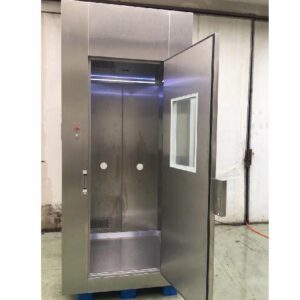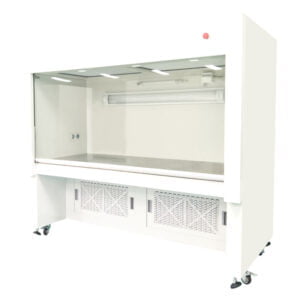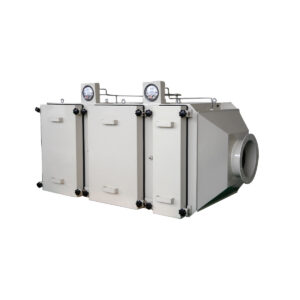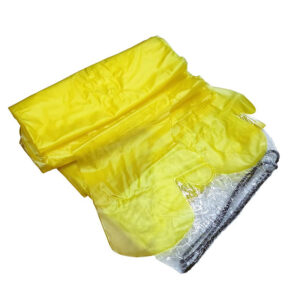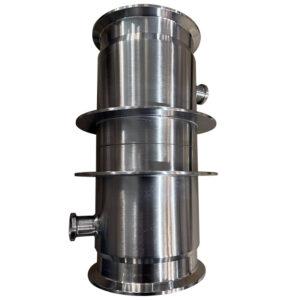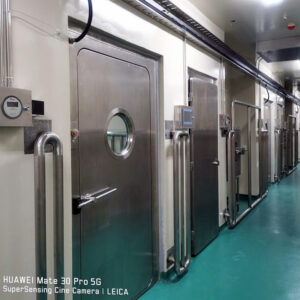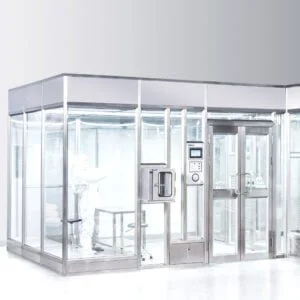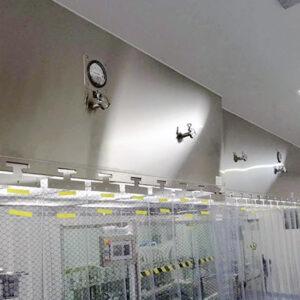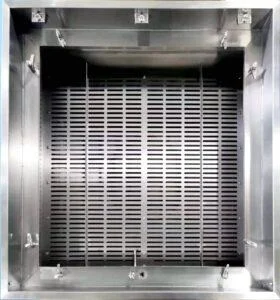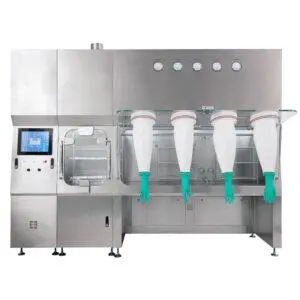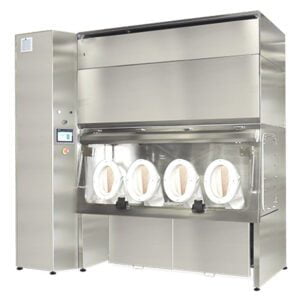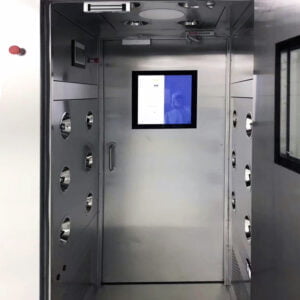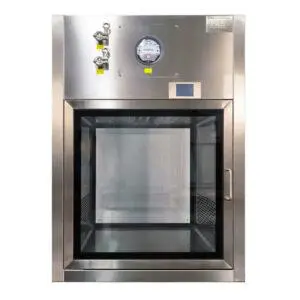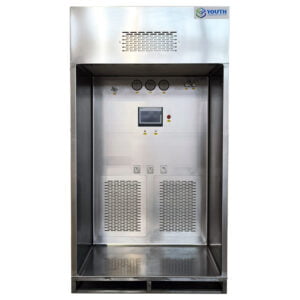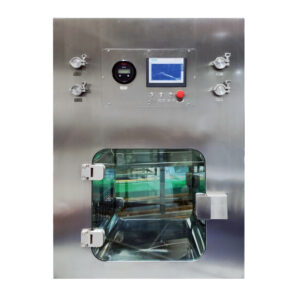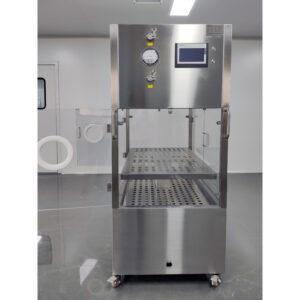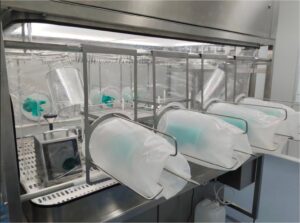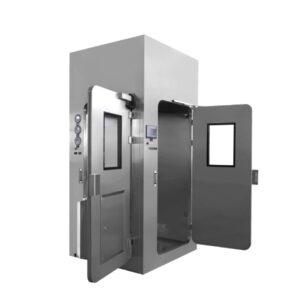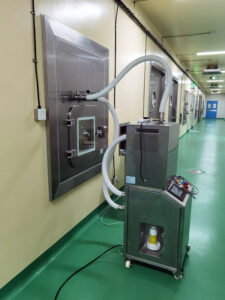Every fan filter unit integrates multiple precision-engineered components that work together to deliver consistent, contamination-free airflow. The primary elements include the filter media, housing frame, fan or blower assembly, motor, electrical controls, and sealing systems.
The housing structure typically uses aluminum extrusion or cold-rolled steel with powder coating to resist corrosion and particle generation. Premium manufacturers implement modular designs that simplify installation and maintenance while maintaining structural integrity under continuous operation. The frame must support the filter weight, withstand airflow pressure, and provide secure mounting points for ceiling grid integration.
Filter media selection depends on cleanroom classification requirements. HEPA filters capture 99.97% of particles at 0.3 microns, while ULPA filters achieve 99.999% efficiency for more stringent applications. The filter must integrate seamlessly with the housing through gel sealing or mechanical clamping systems that prevent bypass leakage.
Fan assemblies generate the airflow volume necessary to maintain cleanroom pressure differentials and air change rates. Forward-curved centrifugal fans offer quiet operation, while backward-curved designs provide higher efficiency. The fan housing requires aerodynamic design to minimize turbulence and pressure loss.
| Component | Material Options | Critical Specifications | Typical Lifespan |
|---|---|---|---|
| Housing Frame | Aluminum extrusion, cold-rolled steel | Corrosion resistance, dimensional stability | 15-20 years |
| Filter Media | Glass fiber, ePTFE membrane | Efficiency rating, pressure drop, media depth | 2-5 years |
| Fan Assembly | Galvanized steel, plastic impeller | Airflow capacity (CFM), static pressure | 10-15 years |
| Motor | EC brushless, AC induction | Power consumption, speed control, thermal protection | 8-12 years |
| Control System | PCB with microprocessor | Variable speed, filter monitoring, alarm functions | 10-15 years |
Motor mounting requires vibration isolation to prevent noise transmission through the ceiling grid. Rubber grommets or spring isolators separate mechanical components from the housing structure. This isolation becomes particularly important in pharmaceutical manufacturing areas where noise levels must remain below 55 dBA.
Electrical control systems have evolved from simple on/off switches to sophisticated microprocessor-based controllers with variable speed drives, filter life monitoring, and network connectivity. These control systems enable real-time performance optimization and predictive maintenance scheduling.
HEPA Filter Technology in FFU Manufacturing
HEPA filter FFU components represent the heart of cleanroom contamination control. Manufacturing these filters requires controlled environments, precise pleating machinery, and rigorous testing protocols to ensure consistent performance across production batches.
Filter media consists of submicron glass fibers arranged in a random matrix that captures particles through interception, impaction, and diffusion mechanisms. The most penetrating particle size (MPPS) occurs around 0.3 microns, which serves as the standard testing benchmark. Premium manufacturers source media from certified suppliers who maintain lot traceability and provide certificate of conformance documentation.
Pleating depth, count, and spacing directly affect filter performance and lifespan. Deep pleats increase media surface area, reducing face velocity and extending filter life. However, excessive pleating can cause pleat crowding that restricts airflow and increases pressure drop. Professional manufacturers optimize pleat geometry through computational fluid dynamics modeling and empirical testing.
“Proper HEPA filter integration accounts for 60-70% of overall FFU performance, with seal integrity and media uniformity being the primary quality control factors in professional cleanroom filtration units.” — International Society for Pharmaceutical Engineering, 2023
Gel sealing or gasket sealing prevents bypass leakage between the filter and housing. Polyurethane gel applied during manufacturing creates an airtight seal that accommodates minor dimensional variations. Gasket systems offer easier filter replacement but require precise manufacturing tolerances to maintain seal integrity.
| Filter Classification | Efficiency Rating | Typical Applications | Initial Pressure Drop | Media Depth |
|---|---|---|---|---|
| H13 HEPA | ≥99.95% @ 0.3μm | General pharmaceutical, electronics | 200-250 Pa | 69mm |
| H14 HEPA | ≥99.995% @ 0.3μm | Sterile manufacturing, hospital operating rooms | 220-280 Pa | 69mm |
| U15 ULPA | ≥99.9995% @ 0.3μm | Semiconductor lithography, critical pharmaceutical | 280-350 Pa | 90mm |
| U16 ULPA | ≥99.99995% @ 0.3μm | Advanced semiconductor, nanotechnology research | 320-400 Pa | 90mm |
Filter testing occurs through automated scanning systems that detect pinhole leaks and manufacturing defects. Aerosol photometry using DOP, PAO, or DEHS particles verifies efficiency ratings across the entire filter face. Each filter receives individual testing documentation that travels with the unit through installation and commissioning.
Frame construction for the filter element uses moisture-resistant materials such as galvanized steel, stainless steel, or plastic. Pharmaceutical applications typically require stainless steel frames that withstand chemical cleaning and resist corrosion from sanitizing agents. The frame must maintain dimensional stability across temperature and humidity variations to prevent seal failure.
Motor Assembly and Airflow Systems
Cleanroom FFU motor assembly has undergone significant evolution with the transition from AC induction motors to electronically commutated (EC) brushless motors. This shift delivers substantial energy savings while providing superior speed control and reduced maintenance requirements.
EC motors integrate permanent magnets and electronic controllers that optimize efficiency across varying load conditions. These motors achieve 80-90% efficiency compared to 60-70% for traditional AC motors. The built-in controller enables precise speed adjustment through 0-10V analog signals or digital communication protocols like Modbus or BACnet.
Motor sizing requires careful calculation of system resistance, desired airflow velocity, and static pressure requirements. Undersized motors struggle to maintain airflow as filters load with particles, while oversized motors waste energy and generate unnecessary noise. Professional manufacturers use fan curves and system curves to select optimal motor specifications.
“EC motor technology in FFU applications reduces energy consumption by 40-50% compared to conventional AC motors while providing better speed control and lower total cost of ownership.” — ASHRAE Journal, 2023
Thermal protection prevents motor burnout from blocked filters or excessive ambient temperatures. Embedded thermistors monitor winding temperature and trigger shutdown before permanent damage occurs. Reset functionality allows automatic restart once temperatures return to safe operating ranges.
| Motor Type | Efficiency Range | Speed Control | Power Consumption (Standard FFU) | Noise Level | Maintenance |
|---|---|---|---|---|---|
| AC Single-Phase | 60-70% | Limited (transformer-based) | 200-280W | 52-58 dBA | Bearing lubrication every 2-3 years |
| AC Three-Phase | 70-78% | VFD required | 180-240W | 50-56 dBA | Bearing lubrication every 2-3 years |
| EC Brushless | 80-90% | Integrated controller | 120-180W | 45-52 dBA | Minimal (bearing lifetime rated) |
Airflow uniformity across the filter face prevents hot spots where higher velocity creates turbulence and reduces cleanroom effectiveness. Diffuser plates or perforated grilles downstream of the fan distribute airflow evenly before reaching the filter media. Manufacturers validate uniformity through velocity mapping at multiple points across the filter face.
Pressure compensation features in advanced motor controllers automatically adjust speed to maintain constant airflow as filters accumulate particles. This functionality extends filter life while maintaining consistent cleanroom performance throughout the replacement cycle.
Manufacturing Standards and Quality Control
Pharmaceutical FFU parts manufacturing operates under stringent regulatory frameworks that govern material selection, assembly processes, testing protocols, and documentation requirements. Compliance with these standards ensures product reliability and facilitates regulatory approval for pharmaceutical and medical device facilities.
ISO 14644 standards define cleanroom classifications and testing methodologies that directly impact FFU specifications. Manufacturers must design units that enable facilities to achieve and maintain required cleanliness levels through proper airflow velocity, filter efficiency, and air change rates.
Good Manufacturing Practice (GMP) regulations require equipment used in pharmaceutical production to meet specific design criteria. FFU components must use non-shedding materials, provide smooth surfaces for cleaning, and resist corrosion from sanitizing agents. Stainless steel construction often becomes mandatory for sterile manufacturing environments.
Certified FFU assembly manufacturing includes documented procedures for every production step. Work instructions specify torque values for fasteners, sealant application techniques, wiring color codes, and inspection checkpoints. This documentation creates traceability from raw material receipt through final shipment.
| Industry Sector | Primary Standards | Material Requirements | Testing Protocols | Documentation |
|---|---|---|---|---|
| Pharmaceutical | GMP, ISO 14644, EU GMP Annex 1 | Stainless steel, non-shedding | IEST-RP-CC006, ISO 14644-3 | IQ/OQ support, material certificates |
| Semiconductor | SEMI Standards, ISO 14644 | Anodized aluminum, low-outgassing | Particle counting, AMC testing | Performance data, contamination analysis |
| Biotechnology | GMP, ISO 14644, cGMP | Stainless steel, cleanable surfaces | HEPA scan, airflow velocity | Validation protocols, 3-D models |
| Healthcare | HTM 03-01, ISO 14644 | Powder-coated steel, antimicrobial | BS EN 12469, ISO 14644-3 | CE marking, performance certificates |
Component testing begins with incoming inspection of purchased parts. Filter media receives verification testing to confirm efficiency ratings match supplier specifications. Motors undergo power consumption measurement and noise testing before integration into assemblies.
Final assembly testing includes HEPA scan testing using photometric methods to detect leaks greater than 0.01% of upstream concentration. Airflow velocity measurements verify uniform distribution across the filter face. Electrical safety testing confirms ground continuity and insulation resistance.
Quality management systems based on ISO 9001 provide the framework for continuous improvement and corrective action processes. Non-conforming products receive documented investigation, and root cause analysis drives process modifications to prevent recurrence.
Custom Component Production and Integration
Custom FFU component production addresses unique application requirements that standard configurations cannot accommodate. Pharmaceutical, biotechnology, and advanced semiconductor facilities often require dimensional modifications, specialized materials, or enhanced performance specifications.
Size customization accommodates ceiling grid variations, space constraints, and airflow requirements. Standard FFU dimensions typically follow 2’x2′, 2’x4′, or 3’x3′ footings, but custom widths, lengths, and heights enable integration into non-standard ceiling systems. Manufacturers with flexible production capabilities can fabricate units from 1’x1′ mini-FFUs up to 4’x6′ large-format systems.
Material upgrades respond to corrosive environments or cleanability requirements. Stainless steel housings replace aluminum for pharmaceutical wash-down areas. Special coatings provide chemical resistance in battery manufacturing or chemical processing cleanrooms. Antimicrobial powder coating reduces bioburden in biotechnology applications.
“Approximately 35% of FFU orders in pharmaceutical applications require some degree of customization, with specialized materials, alternative voltage requirements, or enhanced monitoring capabilities being the most common requests.” — Pharmaceutical Engineering Magazine, 2024
Performance enhancement includes variable speed control, enhanced filtration efficiency, or reduced noise output. Hospital operating rooms may require ultra-quiet operation below 45 dBA. Semiconductor cleanrooms often specify ULPA filtration with enhanced air velocity uniformity. Research laboratories might need explosion-proof motors or intrinsically safe electrical systems.
Integration with building management systems (BMS) has become standard for large facilities. Manufacturers provide FFU systems with communication protocols including Modbus RTU, BACnet, or proprietary network interfaces. These systems enable centralized monitoring of filter pressure drop, motor status, and alarm conditions across hundreds of units.
Voltage and frequency variations require motor specification adjustments for international projects. Standard North American 115V/60Hz or European 230V/50Hz configurations may need modification for 208V, 240V, or 480V three-phase systems. Motor controller programming ensures proper operation across voltage and frequency ranges.
Lead times for custom component production typically extend 2-4 weeks beyond standard models depending on modification complexity. Simple dimensional changes or color variations add minimal time, while custom motor specifications or specialized testing protocols may require 6-8 weeks.
Material Selection and Component Durability
Component longevity directly impacts total cost of ownership through reduced replacement frequency and maintenance interventions. Material selection balances initial cost, performance requirements, and expected service life across diverse operating environments.
Housing materials must resist corrosion from cleaning chemicals, maintain dimensional stability, and minimize particle generation. Aluminum extrusion offers excellent strength-to-weight ratio and natural corrosion resistance. Powder coating provides additional protection and enables color matching to facility aesthetics. Stainless steel 304 or 316 becomes necessary in pharmaceutical environments requiring frequent sanitization.
Plastic components including fan impellers, electrical enclosures, and mounting brackets must resist ultraviolet degradation, chemical exposure, and thermal cycling. Engineering plastics like ABS, polycarbonate, or modified polyphenylene oxide (PPO) provide adequate strength while reducing weight and cost compared to metal alternatives.
Sealing materials create critical interfaces between filter and housing. Polyurethane gel seals accommodate dimensional variations while maintaining airtight integrity. Neoprene or silicone gaskets offer easier filter replacement but require tighter manufacturing tolerances. Material compatibility with cleaning agents prevents premature seal degradation.
Fastener selection prevents galvanic corrosion where dissimilar metals contact in humid environments. Stainless steel screws avoid rust staining on powder-coated surfaces. Captured fasteners prevent loss during maintenance and reduce FOD (foreign object debris) risk in cleanroom environments.
Electrical components including wiring, connectors, and PCBs must withstand temperature extremes, humidity, and potential chemical exposure. UL-recognized components provide safety assurance and simplify facility electrical inspections. Conformal coating on circuit boards protects against moisture and contaminants in high-humidity environments.
Expected service life varies by component and operating conditions. Filter media typically requires replacement every 2-5 years depending on particle loading and operating hours. Motors with proper bearing selection last 10-15 years. Housing structures often remain serviceable for 20+ years with proper maintenance.
Installation and Maintenance Considerations
Proper installation ensures FFU performance matches design specifications and testing documentation. Ceiling grid preparation, electrical connections, and commissioning procedures all impact long-term reliability and cleanroom performance.
Mounting systems must support unit weight plus filter loading without deflection that could compromise seal integrity. T-bar ceiling grids require reinforcement for units exceeding 150 pounds. Bolt-up grid systems provide superior stability for heavy-duty applications. Seismic restraints become mandatory in high-risk geographic regions.
Leak testing during commissioning verifies filter seal integrity using aerosol photometry or particle counting methods. Scan testing detects leaks exceeding 0.01% of upstream concentration. Remediation may require seal adjustment, gasket replacement, or filter reinstallation to achieve specification compliance.
Airflow balancing across multiple FFU units maintains uniform cleanroom pressure and air change rates. Adjustable speed controls or dampers enable fine-tuning to achieve design airflow within ±10%. Pressure differential monitoring between cleanroom zones confirms proper airflow direction from higher to lower classification areas.
Preventive maintenance schedules extend equipment life and maintain performance. Filter pressure drop monitoring identifies when replacement becomes necessary before excessive resistance reduces airflow. Motor inspection includes bearing condition assessment and vibration analysis. Electrical connection inspection detects loose terminals that could cause overheating or failure.
Filter replacement procedures must prevent cleanroom contamination during change-out. Bagging systems capture the used filter while preventing particle release. Integrity testing of new filters confirms no damage occurred during shipping or installation. Documentation updates record replacement dates, filter serial numbers, and test results.
FAQ
What are the main components of a fan filter unit?
The primary components include HEPA or ULPA filter media, housing frame (typically aluminum or steel), motor assembly (AC or EC type), fan or blower, electrical control system, sealing mechanism (gel seal or gaskets), and mounting hardware. Premium units also include pressure monitoring sensors and variable speed controls.
How long do FFU components typically last?
Filter media lasts 2-5 years depending on particle loading, motors function for 10-15 years with proper maintenance, and housing structures can remain serviceable for 20+ years. EC motors generally outlast AC motors due to reduced mechanical wear on brushless designs.
What standards govern FFU manufacturing for pharmaceutical applications?
Pharmaceutical FFUs must comply with GMP (Good Manufacturing Practice), ISO 14644 cleanroom standards, and EU GMP Annex 1 for sterile manufacturing. GMP compliant FFU equipment requires specific material selection, documentation protocols, and testing procedures.
Can FFU components be customized for specific applications?
Yes, manufacturers offer customization including non-standard dimensions, upgraded materials (stainless steel), enhanced filtration (ULPA), specialized coatings, alternative voltages, and integrated BMS communication. Lead times typically extend 2-8 weeks depending on modification complexity.
What’s the difference between EC and AC motors in FFUs?
EC (electronically commutated) motors use brushless permanent magnet technology achieving 80-90% efficiency with integrated speed control and longer lifespan. AC induction motors achieve 60-70% efficiency, require external VFDs for speed control, and need periodic bearing maintenance. EC motors reduce energy consumption by 40-50% compared to AC alternatives.
Conclusion
FFU component manufacturing combines precision engineering, quality materials, and rigorous testing protocols to deliver reliable contamination control for critical environments. From HEPA filter integration to EC motor assembly, each component requires careful specification and manufacturing oversight to ensure long-term performance. Understanding these technical details enables informed equipment selection that balances initial investment with total cost of ownership across pharmaceutical, semiconductor, biotechnology, and healthcare applications. As cleanroom standards evolve and energy efficiency becomes increasingly important, manufacturers who invest in advanced materials, testing capabilities, and customization flexibility will continue leading the industry toward improved performance and sustainability.
External Resources
ISO 14644-1:2015 – International standard specifying cleanroom classification by airborne particle concentration with testing procedures for fan filter units and cleanroom systems.
IEST-RP-CC006.4 – Institute of Environmental Sciences and Technology recommended practice for testing cleanrooms, including HEPA/ULPA filter leak testing and airflow verification protocols.
FDA Guidance for Industry: Sterile Drug Products Produced by Aseptic Processing – Current good manufacturing practice guidelines relevant to cleanroom design and FFU specifications for pharmaceutical manufacturing.
EU GMP Annex 1: Manufacture of Sterile Medicinal Products – European regulatory requirements for cleanroom design, monitoring, and qualification including FFU performance specifications.
ASHRAE Position Document on Filtration and Air Cleaning – Technical resource on air filtration technology, energy efficiency considerations, and system design for cleanroom applications.
USP <797> Pharmaceutical Compounding—Sterile Preparations – United States Pharmacopeia chapter establishing cleanroom requirements for compounding facilities including air filtration specifications.
SEMI S2 – Environmental, Health, and Safety Guideline for Semiconductor Manufacturing Equipment – Safety and design standards for equipment used in semiconductor cleanrooms including FFU specifications.
WHO Technical Report Series: Good Manufacturing Practices for Pharmaceutical Products – World Health Organization guidance on pharmaceutical manufacturing facility design and contamination control strategies.
Related Contents:
- HEPA Housing Boxes in Pharmaceutical Manufacturing: Uses
- Top 3 Fan Filter Unit Applications in Pharmaceutical Manufacturing
- What is the Efficiency Rating of HEPA Housing Boxes?
- Emerging Trends in HEPA Housing Box Technology for 2025
- Proven FFU Maintenance Tips to Extend Unit Lifespan
- Aerospace HEPA Housing Box Requirements & NASA Standards
- Optimizing Airflow Patterns in Fan Filter Unit Systems
- Boosting Productivity with Advanced HEPA Housing Systems
- GMP Compliant Air Filters | FDA Requirements Cleanroom Validation



